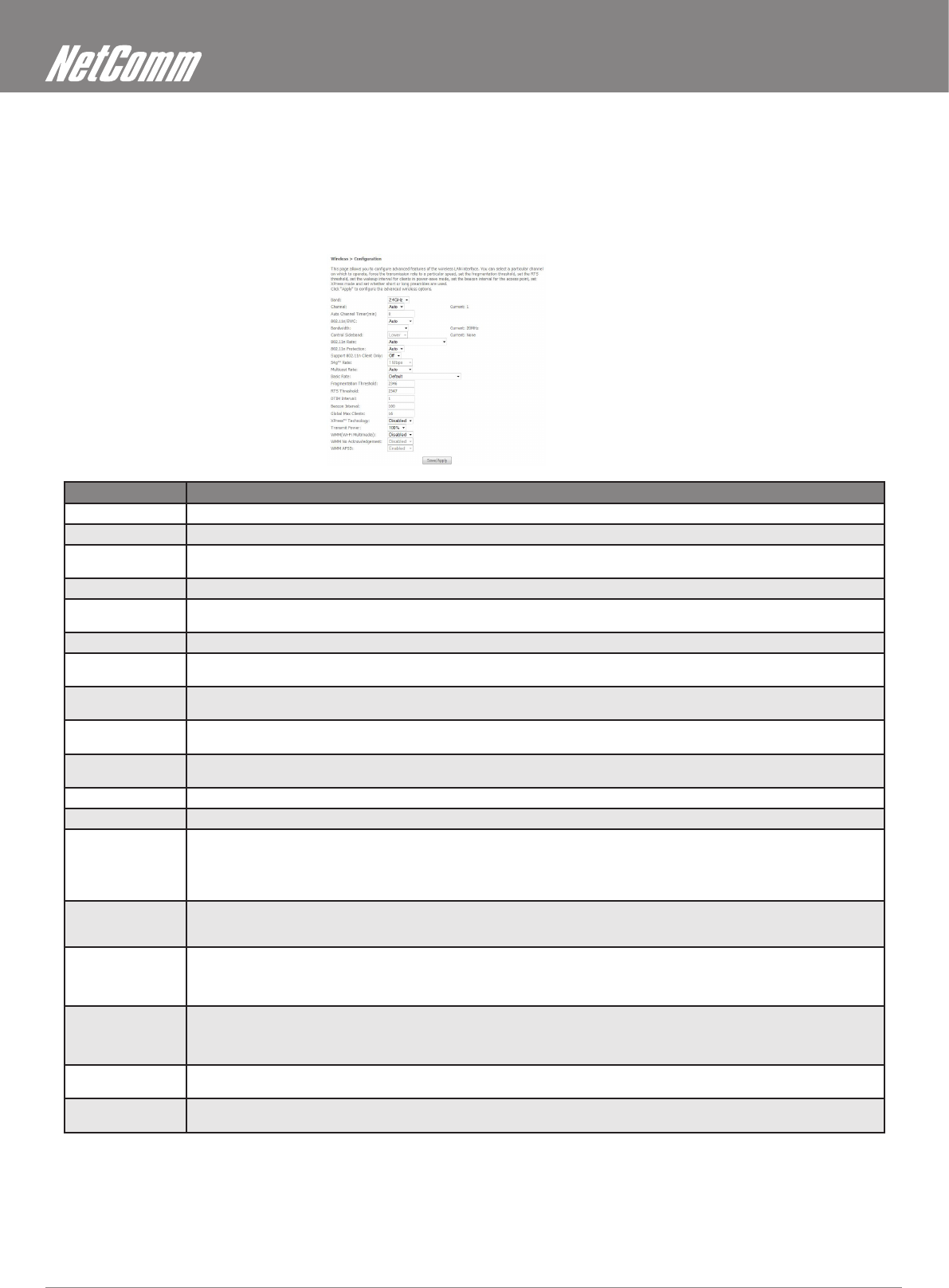
ADSL2+ Wireless N300 Modem Router with VoIP User Guide YML9WMAXXN
36 www.netcomm.com.au
6.4 Conguration
The Conguration screen allows you to congure advanced features of the wireless LAN interface. You can select a particular channel on
which to operate, force the transmission rate to a particular speed, set the fragmentation threshold, set the RTS threshold, set the wakeup
interval for clients in power-save mode, set the beacon interval for the access point, set XPress mode and set whether short or long
preambles are used.
Click Apply to congure the advanced wireless options.
Option Description
Band Frequency band used by the wireless AP. Default is 2.4GHz
Channel Drop-down menu that allows selection of a specic channel.
Auto Channel
Timer (min)
Auto channel scan timer in minutes (0 to disable)
802.11n/EWC With drop-down menu, “Auto” is for 11n and “Disable” is for 11g
Bandwidth Drop-down menu species the following bandwidth: 20MHz in 2.4G Band and 40 MHz in 5G Band, 20MHz in both bands and 40MHz in both
bands
Control Sideband This is available for 40MHz. Drop-down menu allows selecting upper sideband or lower sideband
802.11n Rate Drop-down menu species the following xed rates. The maximum rate for bandwidth, 20MHz, is 130MHz and the maximum bandwidth,
40MHz, is 270MHz
802.11n Protection It is similar as 802.11g protection. In Auto mode the router will use RTS/CTS to improve 802.11n performance in mixed 802.11n/ 802.11g/
802.11b networks. Turn protection off to maximize 802.11n throughput under most conditions.
Support 802.11n
client only
Drop-down menu allows selecting “On/Off”. Choosing “On” allows the client with 11n only to connect, not for 11g or 11b; choosing “Off”
allows the client with 11n/11g/11b to connect
54g Rate Drop-down menu that species the following xed rates: Auto: Default. Uses the 11 Mbps data rate when possible but drops to lower rates
when necessary. 1 Mbps, 2Mbps, 5.5Mbps, or 11Mbps xed rates. The appropriate setting is dependent on signal strength.
Multicast Rate Setting multicast packet transmit rate.
Basic Rate Setting basic transmit rate.
Fragmentation
Threshold
A threshold, specied in bytes, that determines whether packets will be fragmented and at what size. On an 802.11 WLAN, packets that
exceed the fragmentation threshold are fragmented, i.e., split into, smaller units suitable for the circuit size. Packets smaller than the specied
fragmentation threshold value are not fragmented. Enter a value between 256 and 2346. If you experience a high packet error rate, try to
slightly increase your Fragmentation Threshold. The value should remain at its default setting of 2346. Setting the Fragmentation Threshold
too low may result in poor performance.
RTS Threshold Request to Send, when set in bytes, species the packet size beyond which the WLAN Card invokes its RTS/CTS mechanism. Packets that
exceed the specied RTS threshold trigger the RTS/CTS mechanism. The NIC transmits smaller packet without using RTS/CTS. The default
setting of 2347 (maximum length) disables RTS Threshold.
DTIM Interval Delivery Trafc Indication Message (DTIM), also known as Beacon Rate. The entry range is a value between 1 and 65535. A DTIM is a
countdown informing clients of the next window for listening to broadcast and multicast messages. When the AP has buffered broadcast or
multicast messages for associated clients, it sends the next DTIM with a DTIM Interval value. AP Clients hear the beacons and awaken to
receive the broadcast and multicast messages. The default is 1.
Beacon Interval The amount of time between beacon transmissions. Each beacon transmission identies the presence of an access point. By default, radio
NICs passively scan all RF channels and listen for beacons coming from access points to nd a suitable access point. Before a station enters
power save mode, the station needs the beacon interval to know when to wake up to receive the beacon (and learn whether there are buffered
frames at the access point). The entered value is represented in ms. Default is 100. Acceptable entry range is 1 to 0xffff (65535)
Global Max Clients The device can support 4 SSID, and each SSID can set its own max clients, but it can’t be bigger than Global max clients. “Global Max Clients”
limits the total associated clients of the 4 SSID.
Xpress TM
Technology
Xpress Technology is compliant with draft specications of two planned wireless industry standards.


















